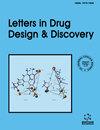Discovering Drug Candidates for Charcot Marie Tooth Disease Type-2
IF 1.6
4区 医学
Q4 CHEMISTRY, MEDICINAL
引用次数: 0
Abstract
Introduction: Charcot Marie Tooth Disease-2 is a debilitating neurogenetic disorder that adversely affects peripheral neurons by disrupting mitochondrial activity. Mutated mitofusin-2 (MFN) is the main culprit behind disruptive mitochondrial function and is considered a therapeutic target in identifying drugs for treating this disease. This disease has no therapeutic medication except for supportive care. Objective: The objective of the current study is to evaluate high-affinity medicinal compounds for mutated MFN-2 and describe their absorption, distribution, metabolism, excretion, and toxic attributes (ADMET). Methods: For ADMET properties, 2,219 medicinal compounds were analyzed with AutoDock Vina using PyRX 0.9 software against MFN-2, SwissADME, and GUSAR. Results: Results from screening studies revealed that three compounds (Liriodenine, Pinocembrin, and Vestitol) show an affinity for amino acids present in the predicted active interface of the MFN-2 protein. Moreover, these compounds render low toxicity and efficient ADME qualities, combined with blood-brain barrier permeability, drug-likeness, and lead-likeness. Conclusion: Liriodenine, pinocembrin and vestitol are therapeutic compounds for CMT-2 treatment and should be used in further in-vitro studies to confirm the results of this research.发现治疗夏可玛丽牙病2型的候选药物
Charcot Marie Tooth Disease-2是一种衰弱的神经遗传疾病,通过破坏线粒体活性对周围神经元产生不利影响。有丝分裂蛋白-2 (MFN)突变是线粒体功能破坏的罪魁祸首,被认为是确定治疗这种疾病的药物的治疗靶点。除了支持性护理外,这种疾病没有治疗药物。目的:本研究的目的是评估突变MFN-2的高亲和力药物化合物,并描述它们的吸收、分布、代谢、排泄和毒性属性(ADMET)。方法:使用AutoDock Vina软件,利用PyRX 0.9软件对2219种药物化合物进行抗MFN-2、SwissADME和GUSAR的性质分析。结果:筛选研究结果显示,三种化合物(Liriodenine, Pinocembrin和Vestitol)对MFN-2蛋白预测活性界面上的氨基酸具有亲和力。此外,这些化合物具有低毒性和高效的ADME特性,并具有血脑屏障渗透性、药物相似性和铅相似性。结论:Liriodenine、pinocembrin和vestitol是治疗CMT-2的治疗性化合物,需要进一步的体外研究来证实本研究的结果。
本文章由计算机程序翻译,如有差异,请以英文原文为准。
求助全文
约1分钟内获得全文
求助全文
来源期刊
CiteScore
1.80
自引率
10.00%
发文量
245
审稿时长
3 months
期刊介绍:
Aims & Scope
Letters in Drug Design & Discovery publishes letters, mini-reviews, highlights and guest edited thematic issues in all areas of rational drug design and discovery including medicinal chemistry, in-silico drug design, combinatorial chemistry, high-throughput screening, drug targets, and structure-activity relationships. The emphasis is on publishing quality papers very rapidly by taking full advantage of latest Internet technology for both submission and review of manuscripts. The online journal is an essential reading to all pharmaceutical scientists involved in research in drug design and discovery.

 求助内容:
求助内容: 应助结果提醒方式:
应助结果提醒方式:


